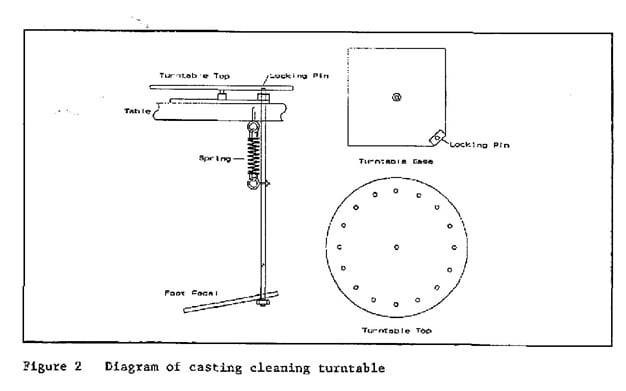Engineering Controls Database
Foundries – Control Technology Recommendations
|
The National Institute for Occupational Safety and Health (NIOSH) has conducted a number of control technology evaluations of foundries. The Engineering Control Technology Branch (ECTB) of the Division of Physical Sciences and Engineering (DPSE) was given the lead within NIOSH to study the engineering aspects of hazard control. The first of these evaluations (171-16a, 171-17a, 171-17b) were done under the Sentinel Event Notification System for Occupational Risks (SENSOR) in conjunction with the New Jersey Department of Health (NJDOH). This surveillance system utilizes morbidity (hospital discharge) data and mortality (death certificate) data to identify cases of silicosis. Health department surveillance data indicate the largest number of silicosis cases in the state exist in the sand mining and processing, pottery (sanitary ware), and foundry industries. This disease is caused by exposure to crystalline silica in these industries. In November 1991, NIOSH received a management request to evaluate worker exposures throughout the General Castings-Powers Street Facility, a gray and ductile iron foundry in Cincinnati, Ohio [NIOSH 1993]. This gray and ductile iron foundry is housed in a masonry building and operated one shift with 32 employees. This initial survey looked at operations in the entire plant and included collection of samples to determine personal respirable silica exposure concentrations. The survey results showed high respirable silica exposure concentrations for the workers in a number of areas including those engaged in casting cleaning operations. The respirable silica concentrations that these workers were exposed to ranged from 124 to 160 µg/m3, 8-hr time-weighted-average (TWA). The NIOSH recommended exposure level (REL) is 0.05 mg/m3 TWA for respirable crystalline silica. The purpose of this study (171-21a) was to evaluate the effectiveness of a ventilation control for reducing the silica exposure concentrations. In 1998, NIOSH initiated a numerical modeling study using computational fluid dynamics (CFD) to evaluate the ventilation system of Eljer Plumbingware, Inc. in Salem, OH. Eljer Plumbingware is a gray iron foundry that had a history of overexposure to silica and carbon monoxide. A costly new ventilation system had been installed but was not effective in reducing exposures to compliance levels. |
|
| In addition to silica and carbon monoxide exposures that may occur in foundries, other airborne hazards are metal fumes and dusts (e.g., lead, nickel, chromium), combustion and decomposition products of mold and core materials (e.g., formaldehyde, hydrogen cyanide, isocyanates). Epidemiological studies suggest that workers in ferrous foundries are at a greater risk of dying from lung cancer than persons in the general population. The risk is a function of the job performed, with molders, metal pourers, and cleaning room personnel having the greatest rate of mortality from lung cancer [NIOSH 1975]. If exposure to airborne hazards at foundries cannot be controlled within compliance limits by ventilation and work practice controls, administrative controls, and monitoring; workers must use respirators despite the cardiovascular demands of the job. | |
|
SENSOR foundry evaluations (171-16a, 171-17a, 171-17b) Three different foundries were evaluated. Recommendations were made to help control occupational exposures. These recommendations were based on a number of well-known principles, including engineering measures, ventilation, work practices, personal protection, and monitoring. Evaluation of a ventilation control for casting cleaning (171-21a) A study was conducted to evaluate the effectiveness of a local exhaust ventilation system for a foundry casting cleaning operation. In this operation, an operator cleans castings using a variety of hand-held chipping and grinding tools. The local exhaust ventilation system consisted of a downdraft booth outfitted with a turntable to make casting manipulation easier. The original control system consisted of only an exhaust duct terminating approximately 3 ft off of the floor, at a distance of approximately 6 ft from the casting cleaning workstation. The new local exhaust ventilation system (Figure 1 and 2) was connected to the existing plant ventilation system through the original ductwork.   Computational fluid dynamics (CFD) modeling (245-11a) Using CFD, a large number of designs were evaluated. While numerical evaluation is less accurate than full-scale experimental testing, the latter method is prohibitively expensive for multiple designs. The design proposed by the ventilation consultant was formulated using expertly-applied, traditional ventilation design techniques. It was recommended that the results of the CFD analysis be used to identify qualitative factors that point the way to an optimal design, and that historical ventilation design be used to finalize the system. The CFD analysis indicated the following: • The existing side supply is effective at limiting horizontal spread of the contaminant plume and providing clean air to the work area. • Floor exhaust near the shake-out table is effective at capturing contaminant. • The existing exhaust ducts act as a kind of ceiling in the work area and thus provide direction to the supply jet aiding its effectiveness. • Overhead exhaust did not have a clear effect. |
|
| 171-16A; 171-17A; 171-17B; 171-21A; 245-11A; | |
|
NIOSH [1975]. Criteria for a recommended standard: Occupational exposure to crystalline silica. Cincinnati, OH. U.S. Department of Health Education and Welfare, Public Health Service, Center for Disease Control, National Institute for Occupational Safety and Health, DHEW (NIOSH) publication 75-120. NIOSH [1993]. Hazard evaluation and technical assistance report. General Castings – Power Street Facility, Cincinnati, OH. Cincinnati, OH. U.S. Department of Health and Human Services, Public Health Service, Center for Disease Control and Prevention. National Institute for Occupational Safety and Health, HETA report 92-092-2333. |
|
| 331511 | |
|
chipping and grinding chipping and grinding foundries foundries metal castings metal castings quartz quartz respirable dust respirable dust silicosis silicosis |
|
| The recommendation developed during the evaluation of the ventilation control for casting cleaning (171-21a) found that, depending upon the type of tool used, the local exhaust ventilation system reduced exposures from 60 to 90 percent from the original configuration. These reductions were found to be statistically significant. |
